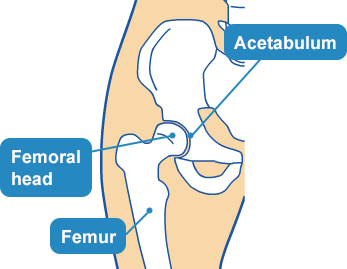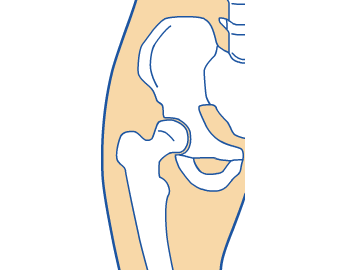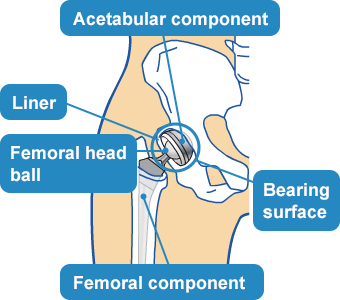- Home
- Products
- Orthopedic and Dental Products
- Technology
- About Hip Joints
Aquala
Introduction to Hip Joints
What is the structure of the hip joint?

The hip joint is composed of a ball portion called the femoral head, and the upper end of the thighbone (femur), which fits into a socket portion of the pelvis called the acetabulum. In a normal hip joint, about 4/5 of the femoral head is covered by the acetabulum, providing a stable hip joint.
A stable hip joint, working in a coordinated manner with the surrounding muscles, allows us to move our legs back and forth and from side to side freely.
The surface of a normal joint is covered by smooth layer called cartilage.
Cartilage, which is free of nerves and blood vessels, consist of about 80% water, function to absorb shocks to the joint, resulting in smooth movement.
In addition, the joint is covered by a sac like envelope called the articular capsule, inside which a membrane called the synovium secretes joint fluid for lubrication and nutritional support.
The normal functioning of cartilages and joint fluid allows us to move our joints with no pain.
However…

When cartilages are worn thin, the bones come into direct contact with each other, causing severe pain and leading to poor joint motion or difficulty walking.
About Hip Joint Diseases
What diseases cause pain in the hip joint?

Osteoarthritis of the hip
Osteoarthritis of the hip is a progressive deformity of the hip due to an abnormal shape or aging of the hip.
It is a disease in which the cartilage or bone of a joint is abraded or deformed, with pain, limited movement, or claudication.
As people get older, the disorder worsens, and if it progresses, it cannot be reversed.
Osteonecrosis of the femoral head
Femoral head necrosis is a disease in which blood flow to the femoral head is impaired.
As it progresses, the head of the bone may become depressed, the articular surface may deform, and the acetabulum may not remain intact and may be destroyed.
Initially, the hip joint is painful when walking or climbing stairs, but as it progresses, the pain may persist.
In addition, the pain causes muscle atrophy and the hip joint's own movement to deteriorate, making it impossible to walk normally.
Rheumatoid arthritis
Rheumatoid arthritis is inflammatory arthritis that affects all joints of the body, with joint swelling, pain, and joint destruction.
The cause is poorly understood but is thought to be an autoimmune disease.
The joint deforms because the autoimmune system affects the cartilage, bones, and ligaments of the joint.
The affected joint may be painful and stiff.
Mechanics of Artificial Hip Joints
How does an artificial hip joint work?

In 1962, Dr. John Charnley, a British surgeon, first devised an artificial hip joint in which polyethylene was introduced as a bearing surface (articular surface), based on the idea of “reducing pain and restoring motion,” successfully lengthening the usage life of artificial hip joints.
This allowed total hip replacement to become a common treatment.
Now, about 50 years later, polyethylene is still used as a material for the bearing surfaces of artificial hip joints because of its superior material properties.
Replacement of the affected joint with an artificial joint made of metal, ceramic, polyethylene, or other materials eliminates pain and improves ambulation. This procedure is called artificial joint replacement surgery and, in Japan, approximately 120,000 patients receive the procedure every year, mainly for the hip joint and knee joint.
Problems with Artificial Hip Joints
What are some problems associated with artificial hip joints?

What are some problems associated with artificial hip joints?
Artificial hip joint replacement does not eliminate all problems. When artificial hip joints are used for a long period, their articular joint may wear, leading to potential loosening.
Loosening may require revision surgery every 10 to 20 years, depending on the patient, and as the patients become older, the revision surgery become more difficult.

About bone resorption and loosening
“Wear debris” from materials is generated in artificial hip joints when the liner and femoral head ball move in contact. When the human body (cells) recognizes wear debris as foreign matter, it responds to induce “bone resorption,” a process in which bone around the artificial hip joint is resorbed. As a result, a gap is formed around the artificial hip joint that was previously securely fixed.
This is called “loosening.”
It goes without saying that examination of materials for artificial hip joints has been conducted in order to reduce wear debris, including the use of metal materials resistant to wear. However, it has been reported that such measures result in the occurrence of problems with other soft tissues or bones, and even a change of materials has not resolved the occurrence of all problems.
A New Era for Artificial Hip Joints
Are more durable artificial hip joints feasible?


